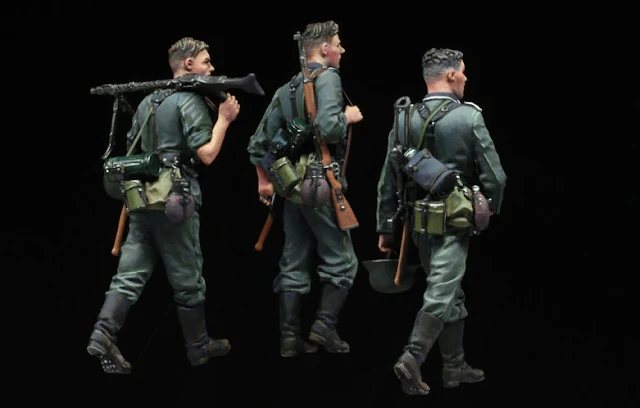The march to Stalingrad starts at Barbarossa - Three new figures in 35th...
The Subject: The German Soldier in the opening stages of Operation Barbarossa
On June 22nd of 1941, the German army and her allies launched a surprise invasion of the Soviet Union. With some 3.5 million German and nearly 700,000 German-allied troops (Romanians, Finns, Hungarians, Italians, Slovaks, and others) facing off against a Red Army that numbered some 5.5 million men, the opening phase of Barbarossa saw nearly 10 million human beings locked in mortal combat from the outset. And Soviet mobilization wasn’t finished by a long shot—soon there would be more than 14 million men and women called up for the war against the Germans.
A map of the initial assault into Russia by Germany commonly thought of as Operation Barbarossa
The Germans employed 138 divisions, plus 36 of their allies (16 Finnish, 15 Rumanian divisions, three Italian, and two Slovakian). plus eight Hungarian brigades, the equivalent of almost 180 divisions. The Red Army consisted of 304 divisions at the time, spread around over the massive area of the Soviet Union (a country that sprawled across 11 time zones in that era).
Barbarossa included massive encirclements by the Germans at Bialystok and Minsk in the opening weeks, and a mega-encirclement at Kiev in the opening months. That last one trapped four complete Soviet armies, the 5th, 37th, 26th, and 21st, and netted nearly 700,000 Soviet prisoners of war.
Take the first six months. The Soviets hung on, grimly and barely, in this opening phase, as the Germans drove towards Moscow. By December 1941, the Red Army had suffered four million casualties, three million of whom were starving in German POW camps. Hopes were high, both in the German high command and at the front, that the Third Reich had won the war.
German Soldiers Marching in the East in 1941
To stop the advance, the Soviets amassed 17 fresh armies in front of the Soviet capital, General G. K. Zhukov launched a vast counterstrike in early December that inflicted punishing losses on the invader and that sent German forces—exhausted, freezing, under strength, and under-supplied, reeling back in some confusion. For a time, it appeared the mighty Wehrmacht might dissolve altogether under Zhukov’s hammer blows. The Germans rallied, however, partially due to an order from Hitler forbidding retreat under any circumstances. By now, the Wehrmacht had suffered one million casualties of its own on the Eastern Front. The human cost of the war in the east, one of its distinguishing features, was determined in these opening months. And in the peculiar mathematics of this bloodbath of a campaign, the Soviets could replace their losses more efficiently than the Germans could.
Although Operation Barbarossa could be used for most of the attacks on the Eastern front. It is commonly accepted that the operation ended with the siege and defeat of the Germans at Stalingrad in 1943.
The Figures from Stalingrad:
Three figures from Alexander Zelenkov's talented hands. These are supplied as three in one set. Unassembled in light grey resin. All are seen on the hard road east, with equipment loading them down and weapons slung over their shoulders as the long march continues. Plenty of dust and long flat plains await these figures in your diorama.
Seen painted up. You can pick out even more detail under the sculptor's careful shading. The field grey tunic and pants that symbolize the early Barbarossa advances. You can see the unterofficer's braiding around his collar as he walks forward confidently at the front of the trio, Mp40 strapped over his shoulders.You can see from the rear that these soldiers each carry the standard early WWII German soldier's loadout. With round gas mask cannister, flask and water bottle, bread bag and entrenching tool with their helmets slung in their webbing.
Seen from the reverse angle, the painted figures have plenty of depth and detail. Each of the soldiers are afforded delicate facial features, wrinkles in their clothing and good body language that conveys their walking gait, endlessly forward...
These figures are sold as a single set - they are available right now - check these out and all of Alexander's other works at the Stalingrad Website:
















